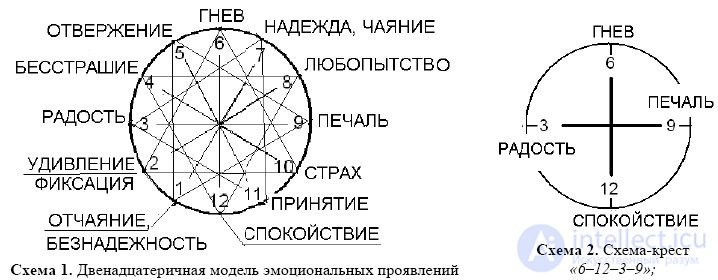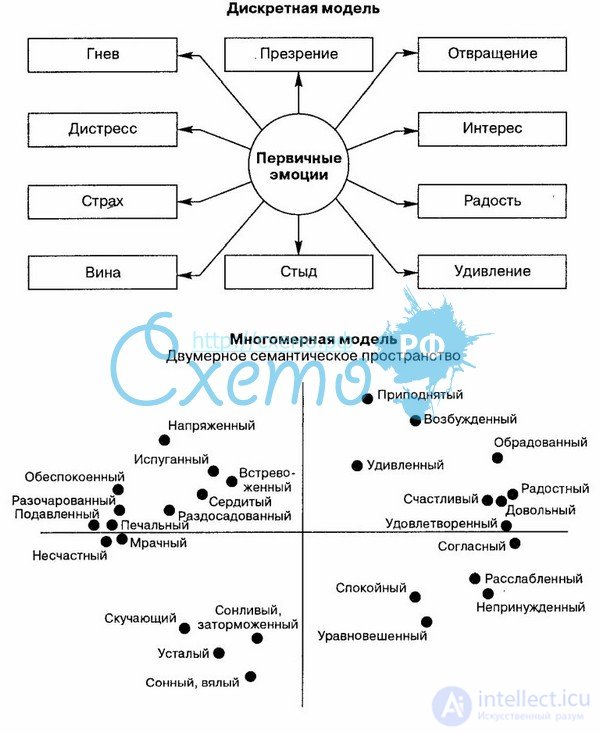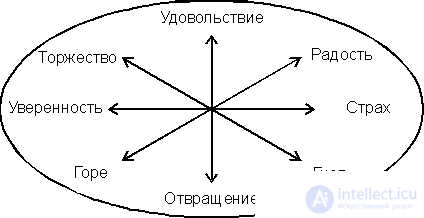In modern psychology, the concept has been established, according to which the infinite variety of a person’s emotional life is caused by the interaction of only a few basic emotions. Each of them has its own valence. In accordance with the signs of this valence, four pairs of opposing basic emotions are distinguished: pleasure - disgust, joy - grief, triumph - anger, confidence - fear. The scale of emotions is not linear, but circular. Schematically, it looks like this:
This scheme clearly confirms the legitimacy of the traditional division of all emotions into positive (sthenic) and negative (asthenic). The first are those that contribute to the spiritual ascent, give a person energy, increase volitional activity. The second group of emotions weakens the will, reduces activity, predisposes to passive-defensive actions, worsens the organization of behavior. Consequently, in a psychologically prepared fighter, positive emotions should always prevail over negative ones.
According to the same concept, emotional states are divided into short-term and long-term. The first are direct reactions to specific situations. The second (they are often called feelings) are determined not only by the moment directly experienced, but also by the past and future of human life. For example, the feeling of fear, poisoning someone's daily existence, may be associated with the danger experienced in the past or determined by thoughts of impending death. For the psychological preparation of a fighter, it is essential that both the situational emotion of fear and fear as a deep-seated personality trait have the same foundation. This basis is a sense of the threat of death, the cessation of existence. Therefore, everything in the world, which directly or indirectly leads to death (if only in the imagination of this person), is the reason for the emergence of his emotions of fear. It should also be noted that a person who is dominated by asthenic emotions in the personality structure experiences fear more often and stronger than an individual with dominance of positive states.
The treasury of natural science knowledge and the system in which the world around us exists make it possible to implement the ideas of systematic learning. In psychology, which, in essence, is a natural science discipline (and for many years was “based” on the biological faculty of universities), this is now especially relevant.
There are various emotional manifestations of the human psychic sphere: feelings, moods, emotional states, as well as the so-called basic emotions (Breslav G. “Psychology of Emotions”, 2004); At the same time, the octal model of basic emotions is known (Pluchik, 1962), which, unfortunately, is still widely used as an educational-methodical scheme for the presentation of issues related to the psychology of emotions. The correctness of the octal model P. Placik is doubtful, however, the absurdity of the situation with eight months of the year or eight (instead of 12) tones of the scale is obvious. The incompleteness and mistakes in the model of Robert Placik, in which the emotion opposite to anger is fear, can be proved using arguments from both music theory and emotion theory, etc.
The purpose of this work is, firstly, the statement (with reference to the topic of this work) ideas about the effectiveness of using for solving educational and methodical problems of the duodecimal model, and, secondly, a demonstration of this author's model.
The basic natural science basis for classifications is the quaternary model (four directions, four seasons, etc.); more detailed - duodenal model. The basis of the proposed duodenal model (see diagram 1) consists of three cross schemes: “6-12-3-9” (see diagram 2); 2) "5-11-2-8"; 3) "4-10-1-7." See diagrams 1 and 2.
Conclusion: the first published 12-year-old model of emotional manifestations reflects systemic connections, is fundamental and will lead to a revision of well-known didactic patterns and methods of teaching issues related to the psychology of emotions.





Comments
To leave a comment
Psychology of emotions
Terms: Psychology of emotions